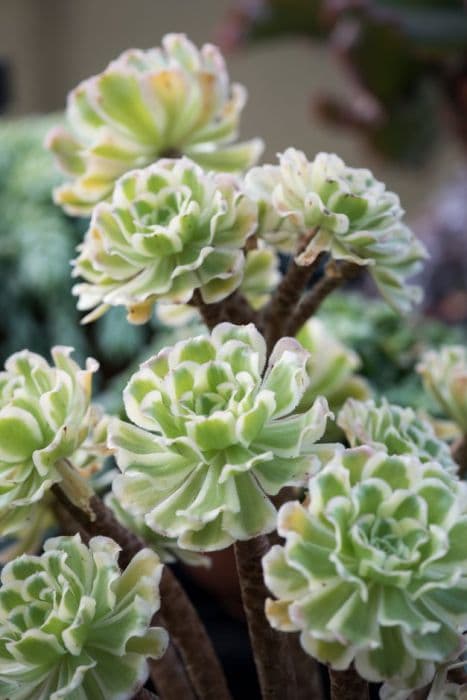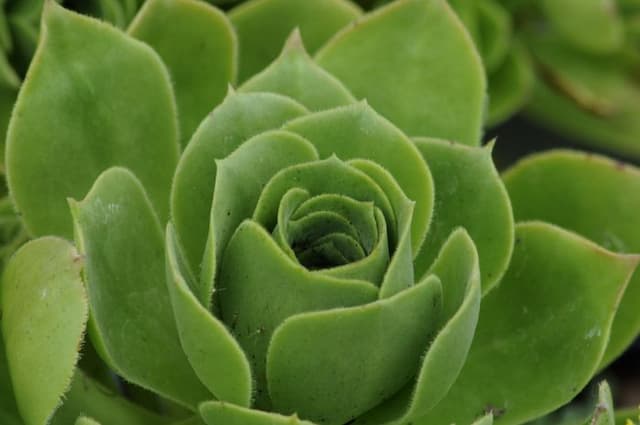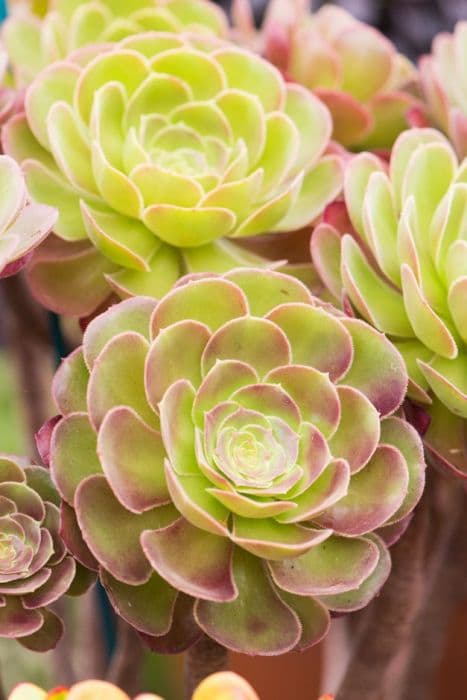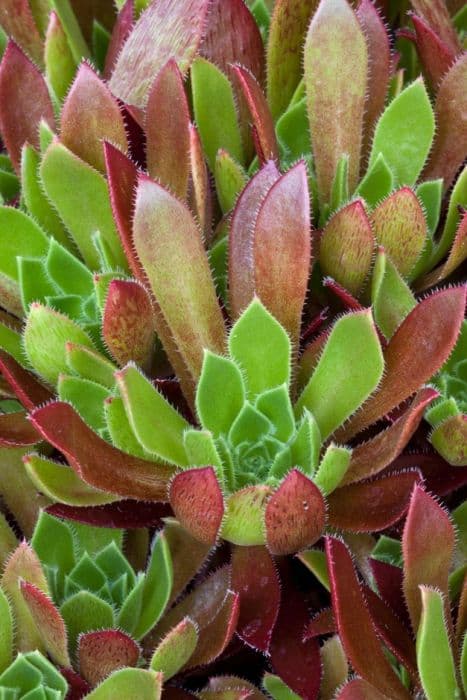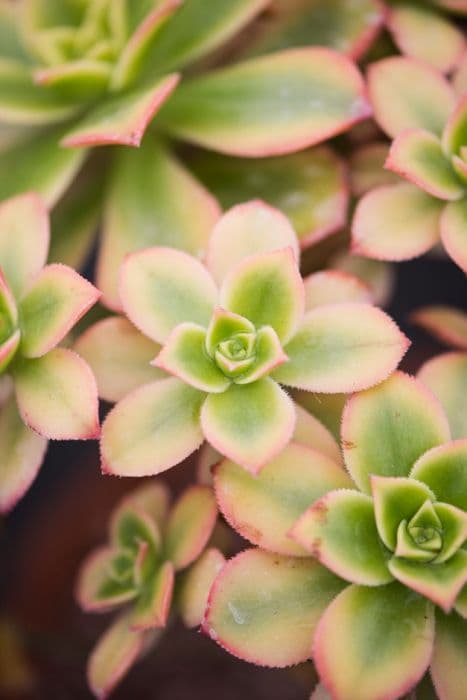Houseleek Sempervivum 'Reinhard'

ABOUT
Sempervivum 'Reinhard', commonly known as houseleek, is a succulent plant with a striking and symmetrical appearance. This perennial forms rosettes that are composed of thick, fleshy leaves. These leaves are quite tactile, often with a slightly rubbery texture that can feel robust to the touch. They are typically green in color, but the tips of the leaves may be tipped with a contrasting hue such as red or purple, especially when exposed to more sunlight or during temperature fluctuations. The houseleek's leaves are pointed and may curve upwards or lay flat, creating a dense and layered look that is very structured. The overall shape of each rosette resembles a natural geometric pattern, with leaves arranged concentrically, and can appear almost artichoke-like from a distance. During the flowering period, which is often in the summer months, the plant may produce flower stalks topped with star-shaped blossoms. The flowers are typically a contrasting color to the foliage, adding an extra layer of visual interest to this already eye-catching plant. After flowering, those specific rosettes that have bloomed will usually die off, making way for new growths to take their place. Houseleeks are generally known for their hardiness and the ability to withstand harsh conditions, often found growing in rocky or poor soil environments. Their succulent leaves are their lifeline, able to retain moisture and sustain the plant through dry periods. As a result, houseleeks can often have a plump and well-hydrated appearance, with a waxy or matte finish on the leaves that helps to reduce evaporation. Sempervivum 'Reinhard' makes an attractive choice for gardeners who wish to add a touch of architectural form to their plantings without much maintenance. Its resilient nature and visually pleasing form make it a popular choice for rock gardens, container arrangements, and as groundcover, where it can spread to create a tapestry of rosettes over time.
About this plant
 Names
NamesFamily
Crassulaceae
Synonyms
Hen And Chicks, Houseleek
Common names
Sempervivum 'Reinhard'.
 Toxicity
ToxicityTo humans
Houseleeks, including the variety Sempervivum 'Reinhard', are generally considered non-toxic to humans. There are no widely recognized symptoms of poisoning from this plant since it isn't known to be poisonous if ingested.
To pets
Houseleeks, known as Sempervivum 'Reinhard' in this variation, are not toxic to pets. They are commonly grown in gardens and homes and do not pose a risk of poisoning to animals, so no symptoms are expected if pets ingest any part of this plant.
 Characteristics
CharacteristicsLife cycle
Perennials
Foliage type
Evergreen
Color of leaves
Varies
Height
6 inches (15 cm)
Spread
12 inches (30 cm)
Plant type
Succulent
Hardiness zones
4
Native area
Europe
Benefits
 General Benefits
General Benefits- Low Maintenance: Sempervivum 'Reinhard', also known as Hen and Chicks, is a succulent plant that requires minimal care, making it ideal for busy or novice gardeners.
- Drought Resistance: Adapted to survive with little water, this plant is great for xeriscaping and water-efficient gardening.
- Cold Hardy: It withstands cold temperatures well, often surviving in USDA hardiness zones as low as 3 or 4.
- Easy to Propagate: The plant produces offsets ('chicks'), allowing for easy propagation and the creation of more plants for the garden or to share with friends.
- Versatile in Landscaping: It can be grown in rock gardens, containers, groundcovers, and green roofs, offering a range of design options.
- Evergreen: Hen and Chicks maintain their foliage throughout the year, providing consistent visual interest in the garden.
- Attracts Pollinators: During flowering, the plant can attract pollinators such as bees, benefiting the local ecosystem.
- Diverse Aesthetics: The rosettes offer a unique and attractive shape, with varying colors that can change with the seasons, adding beauty to garden spaces.
 Medical Properties
Medical PropertiesThis plant is not used for medical purposes.
 Air-purifying Qualities
Air-purifying QualitiesThis plant is not specifically known for air purifying qualities.
 Other Uses
Other Uses- Biological Pest Control: The Sempervivum, also known as Hen and Chicks, can attract beneficial insects like bees and butterflies, which help control garden pests.
- Green Roofing: Hen and Chicks plants are often used in green roofing due to their hardiness and low maintenance, providing insulation and reducing runoff.
- Education: They can be used to teach children about plant propagation, as they easily produce offsets that can be grown into new plants.
- Container Gardening: Hen and Chicks is ideal for embellishing container gardens, adding texture and interest with their rosette form.
- Feng Shui: In Feng Shui, Hen and Chicks is sometimes incorporated into gardens to add balance and harmony with its symmetrical growth pattern.
- Craft Projects: The rosettes can be used in living wreaths or as natural decorations in various craft projects.
- Garden Borders: They can serve as low-growing borders for garden beds, offering a distinctive and hardy edge year-round.
- Jewelry Making: Small rosettes can be used to make living jewelry, such as brooches or pendants.
- Soil Erosion Control: These plants are effective in preventing soil erosion on slopes due to their dense growth habit and extensive root system.
- Photography: Hen and Chicks, with their geometric patterns, are a popular subject for plant photography and botanical art.
Interesting Facts
 Feng Shui
Feng ShuiThe Hen and Chicks is not used in Feng Shui practice.
 Zodiac Sign Compitability
Zodiac Sign CompitabilityThe Hen and Chicks is not used in astrology practice.
 Plant Symbolism
Plant Symbolism- Longevity: The common name for Sempervivum 'Reinhard' is 'houseleek,' which is known for its robust nature and ability to thrive in harsh conditions. It symbolizes endurance and the passage of time.
- Protection: Historically, houseleeks were planted on rooftops to protect against lightning and fire. Thus, they symbolize safeguarding and defense from harm.
- Perseverance: Houseleeks can survive with minimal water and care, symbolizing the ability to persevere and adapt in challenging environments.
- Renewal: With their tendency to produce offsets and spread, houseleeks represent regeneration and continuous renewal.
- Self-sufficiency: Houseleeks do not need much from their surroundings to flourish, thus, they stand for independence and self-reliance.
 Water
WaterHen and chicks should be watered sparingly, as they are drought-tolerant plants that store water in their leaves. Water deeply but infrequently, aiming for every 7-10 days during the growing season, depending on weather conditions. Ensure the soil is completely dry before watering again—use approximately 1 gallon of water per square foot every time you water. During the winter, reduce watering to once a month or less, as the plant enters dormancy and requires even less moisture.
 Light
LightHen and chicks thrive in full sun to partial shade conditions. They are best placed in a spot where they can receive at least 6 hours of direct sunlight daily to encourage strong growth and vibrant coloration. However, in very hot climates, some afternoon shade can be beneficial to prevent scorching.
 Temperature
TemperatureHen and chicks are hardy in a wide range of temperatures and can survive in temperatures as low as -30°F and as high as 90°F. However, they grow best in temperatures between 65°F and 75°F. Ensure they are protected from extreme cold by providing suitable winter cover if necessary, especially in areas where winter temperatures drop below their minimum tolerance level.
 Pruning
PruningHen and chicks typically do not require regular pruning. However, you may remove dead or damaged leaves at any time to maintain plant health and appearance. After flowering, the main rosette that produced the bloom will die, and this can be gently pruned away to encourage pups or offsets to fill in the space. The best time for pruning is typically in the spring or early summer, which allows new growth to emerge and flourish.
 Cleaning
CleaningAs needed
 Soil
SoilHen and chicks (Sempervivum 'Reinhard') thrive in a well-draining soil mix with a pH ranging from 5.6 to 7.5. A suitable recipe includes a combination of potting soil, coarse sand, and perlite or pumice in equal parts to ensure good drainage and aeration.
 Repotting
RepottingHen and chicks typically need repotting every 2 to 3 years to refresh the soil and accommodate their growth. It's best to repot in the spring or early summer when the plant is actively growing.
 Humidity & Misting
Humidity & MistingHen and chicks prefer a dry climate and do not require high humidity. They are well-suited to arid conditions typically found in their natural habitat and will thrive with low to average room humidity.
 Suitable locations
Suitable locationsIndoor
Place in bright light with good airflow.
Outdoor
Full sun to partial shade; well-drained spot.
Hardiness zone
3-8 USDA
 Life cycle
Life cycleThe life of the Hen and Chicks (Sempervivum 'Reinhard') begins with seed germination, given proper conditions of moisture and temperature. The seeds develop into small rosettes, which mature into larger, succulent rosettes that form the characteristic “hen” of the plant. These hens will produce offsets, or “chicks,” through vegetative reproduction, where the chicks spread around the base of the mother plant and eventually take root to form new plants. The plant reaches maturity between 3 to 4 years, at which point it will flower only once in its lifetime, typically in the summer, producing star-shaped flowers on a stalk. After flowering, the central rosette, or “hen,” dies, leaving behind the offsets to continue the life cycle. Over time, these chicks will grow, mature, and repeat the flowering process, ensuring the propagation of the Sempervivum 'Reinhard'.
 Propogation
PropogationPropogation time
Spring-Early Summer
Sempervivum 'Reinhard', commonly known as Hen and Chicks, primarily propagates through offsets, which are small rosettes that form at the base of the parent plant. Propagation is best undertaken during the spring or early summer for optimal growth. To propagate, carefully remove the offsets from the main plant by gently twisting them off or cutting them with a clean, sharp knife. Be sure to include a portion of the stem. Allow the offset to callous over for a few days by leaving it in a warm, dry location out of direct sunlight. Once calloused, plant the offset in a well-draining soil mix. Water sparingly, just enough to moisten the soil without saturating it, which might be approximately 1/4 cup (about 60 milliliters) of water, depending on the size of the offset and the pot. With proper care, these offsets will root and grow into new independent plants.
